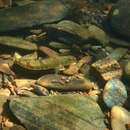The snail darter,
Percina tanasi, a small, extremely local freshwater fish of the family Percidae (perches and darters), was discovered in the Tennesee River in 1973, at the same time as construction of the nearby Tellico Dam. This darter was declared an endangered species in 1975 under the Endangered Species Act (ESA) of 1973, and became an icon for both the conservationist movement and anti-environmentalists as concerns that the Tellico dam would extirpate the species by destroying its only known habitat delayed dam construction for two years. During these years legal controversy ensued and the case made it to the Supreme Court, which ruled to uphold the ESA protection and close down the dam. As a result, congress amended the ESA to allow a subsequent committee (the “God Committee”, so called for its potential to command the extinction of a species) to exempt certain species from protection when economically unviable. However this committee also voted to uphold the darter’s protection. Finally congress passed an amendment excluding the Tellico dam from the ESA and the almost-completed dam project was allowed to proceed; it was completed in 1979. In 1975 snail darters were introduced into four eastern Tennessee river systems; the 710 transplants into the Hiwasssee River successfully established populations which became robust enough to upgrade the snail darters’ status to “threatened” in 1984. The IUCN assessed their status as “vulnerable” in 1996. The snail darter is named for its dietary preference for aquatic snails, which make up the majority of this fish’s diet, although it also eats other small invertebrates. A short-lived species, they live about four years in captivity, and grow up to about 9 cm long. Snail darters spawn in rocky shoals. The eggs rest on gravel bottoms until they hatch about 20 days later, and the young drift downstream, later returning to the shoals to spawn as adults. (
Fuller and Neilson 2012;
Hall 1999;
IUCN 2011;
Wikipedia 2011;
Wikipedia 2012)

